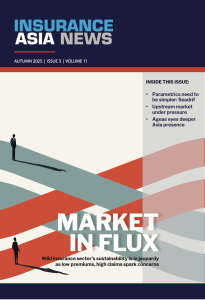Reinsurance market grapples with geopolitical risks amid renewals shift
July 9 2025 by Mithun Varkey
The elephant in the room for the reinsurance market as it looks ahead, having wrapped up all the big renewals this year, is what the global geopolitical and macroeconomic environment brings to bear on the industry.
At a webinar co-hosted by InsuranceAsia News and Fitch Ratings last week, industry experts highlighted the importance of open borders and diversifying the capital base while addressing the risks of a potential rate reduction spiral, the challenges posed by emerging risks, finding avenues for growth and the potential implications of de-dollarisation.
Kicking off the panel, Reinsurance in Transition: Growth, Capital and Emerging Risks, Swiss Re’s Asia Pacific chief economist John Zhu, discussing the impact of the global tariff war, noted that in a “more fragmented world, unfortunately, firms [and] consumers just face generally greater risks, including more volatile exchange rates and asset prices”.
“The political fragmentation unfortunately means reduced international cooperation on mitigating critical risks like climate change or cyber pandemics, etc. So overall increasing global risk exposure,” Zhu said.
Reflecting on the impact of geopolitical developments on reinsurers’ ability to bring lower cost of capital to their clients, Blake Dimitrijevic, chief executive officer of Hannover Re Australia, said: “For the global reinsurance market to function and to provide that value proposition requires open borders, free movement of capital, free movement of liquidity.”
“Whenever we have restrictions on our ability to pool not just the risk and the diversification, but our capital base, and also our liquidity, that’s where pressure can come on our own internal cost of capital and what we have to charge within fundamental underwriting pricing to our clients.
“That’s a very big topic that we’re all considering. And strategies are being put in place and thought about,” he said.
Mark Morley, chairman of Gallagher Re, Asia Pacific, said: “Any reaction that looks to solve by increasing a protectionist approach is flawed in truth, as it has been in the past.
“What we wouldn’t like to see is an increasing level of regulatory protectionism being introduced into the region in response to any number of the macroeconomic elements,” he said.
While the world has been down this path in the past, the general direction of travel had been towards a more open and expansive recognition of the need to diversify risk rather than concentrate risk.
A reversal of that trend would be a “source of genuine concern,” Morley said.
Kanishka de Silva, director, Asia-Pacific Insurance at Fitch Ratings, noted that while the trade war is of concern, from a credit perspective, this is more an earnings event for most insurers rather than one with a capital impact.
“Most APAC-based reinsurers focus mainly on their domestic markets, so the direct impact from the trade war is relatively limited, but they are more affected by shifts in investment markets.
“For Europe’s major reinsurers, there is some sensitivity to what happens in the US both in terms of business exposure and dollar movements. Most of that exposure is managed within local subsidiaries but a weaker dollar or softer US performance still could impact results at the group level,” he said.

“We haven't seen a cooling off of that price reduction acceleration. So I am thoughtful and cautious about what the implications are for 1.1 2026.”
Mark Morley, Gallagher Re
Renewals trends
With the big three rounds of renewals behind us in the Asia Pacific, there is consensus that there is an acceleration in rate reductions across the globe, but the question it raises is whether the softening will cool off.
What has been seen in 2025, though, is a return to a reinsurer earnings environment that is now, for the first time in some years, significantly above the weighted average of capital, Gallagher Re’s Morley said.
“I have seen an acceleration in the price reductions we’ve seen from 1.4 through to 1.7,” he noted.
“This is encouraging for our clients, but what we don’t want to return to – for both reinsurers and clients – is a snap back to reactive pricing that we saw in the market cycle running up to 2025.”
“We haven’t seen a cooling off of that price reduction acceleration. So I am thoughtful and cautious about what the implications are for 1.1 2026,” said Morley, adding that the industry wants to find a sustainable level.
Elaborating on the developments of the just-concluded July 1 renewals, Dimitrijevic said: “We had a little bit different dynamic down here in that we had on the horizon some significant M&A going to occur in the market and I expect this to be a regional theme.
“With a shrinking client base and increased capacity, reinsurers wanted to put a strong footing on the ground to secure placements knowing how that landscape will evolve over the pursuing period.”

“Where reinsurers have tried to meet demand is what we would call in the sub-layers through structured solutions, whereby we can find ultimately win-win scenarios.”
Blake Dimitrijevic, Hannover Re
Dimitrijevic said: “Cat aggregates are always a classic sign of softening. All the analysts have been asking the big reinsurers about it at investor calls and so forth. I don’t think that in Australia in 1.7, we’ve necessarily seen a return to that market. But I think there’s still a lot of caution from the tier ones.”
Dimitrijevic noted that, looking beyond the fixation with pricing, there hasn’t been any relaxation in terms and conditions by an insurer.
While retentions had to rise in the past due to high-severity and high-frequency events, it doesn’t mean that there isn’t flexibility.
“Where reinsurers have tried to meet demand is what we would call in the sub-layers through structured solutions, whereby we can find ultimately win-win scenarios.
“The downside may be mitigated from a reinsurance perspective, but where there’s a good year from a claims perspective, the cedents can also benefit from the upside. I think there’s certainly, you know, a market to engage and have a discussion there.”
According to Morley, “We are seeing a similar level of capacity interest in those solutions, both aggregate cover and structured solutions, that we have seen, I think, at any time of the cycle. What’s different, though, is that it has a different price point. But now the question is whether that’s a sustainable price point.”
Morley noted that the ability to access aggregate covers and structured solutions at the lower end of programs has not just an earnings volatility impact – it has a capital position impact for a number of rest of Asia insurance companies.
Finding growth
While the prospects of market consolidation in Australia point to potentially shrinking demand for reinsurance in the coming years, the experience from 1.1 and 1.4 has been that there has been a reduction in limits purchased in other Asian markets, including Japan.
Explaining the demand dynamics in the region, Morley noted: “If we think that in an increasingly regulated world where maintenance of solvency ratios is of increasing importance, the effectiveness of reducing the risk charge element of the calculation, so rather than trying to increase the equity side, the denominator, rather than reducing the risk charges, the numerator, has been the standard goal of rest of Asia clients in the region.”
Where the price of reinsurance goes up, it is very difficult for cedents to pivot to a new capital model.
“We saw, therefore, some contraction in local portfolios,” he said.
The return of a fairly priced or reasonably priced – or deemed fairly priced – reinsurance allows cedents to return to a capital model they’re comfortable with.
Morley said: “I expect we’ll just see that reverse in a company, so we will see an increased demand for solutions from our clients that look at reducing that risk charge element of that calculation.”

“One emerging risk is whether the US dollar has lost some of its credibility. It is something that I don't think the industry and even the financial sector as a whole is really prepared for.”
John Zhu, Swiss Re
Emerging risks
One of the key themes for reinsurers in the region going into the 2025 renewals cycle was diversification and catering to the growing demand for emerging risks in the region, including cyber, renewables, and other specialty lines.
Reflecting on how the buzz has translated in the recent renewals cycle, Morley held that there are very few cedents out there and only a handful of reinsurers that don’t have a cyber proposition by now.
However, the concern is whether the demand has matched the supply, and Morley thinks that on cyber, particularly on the personal cyber side, the market may have got a little ahead of itself.
“There’s the natural benefit of diversification, not only because there is a reinsurance technical theory that a more diversified portfolio will perform better, but also that reinsurers tend to recognise a more diversified portfolio with a different pricing approach than they may do with a monoline focused portfolio,” he noted.
However, cyber is perhaps oversupplied and suffering from a lack of full development of demand yet.
A view broadly echoed by Hannover Re’s Dimitrijevic.
“Everyone’s fighting over the same pool of business. The pot isn’t growing just yet. We need to be a little bit more active in tailoring products for the region,” he said.
While cyber in the US or UK has far more third-party liability coverage built into the products, given the court system in Asia, that level of coverage is probably not needed.
“We can think about whether lower retentions and lower attachment points might make sense for this part of the world. I think as reinsurers, we need to get our head around that, but we’re certainly investing into the region,” he added.
On renewables, Morley remarked that it is the new cyber.
“What was a very niche line, usually dealt with through the facultative distribution, is now a consistent source of demand across our portfolios,” he said.
Renewables could broadly be classified in the construction camp – long tail, complicated projects that take time to complete and have challenges inherently embedded within the coverage element cycle of those coverages.
“We don’t know what’s bowling down the road towards us, but it’s going to be something for sure.
“But already we’re seeing a cyber-esque redeployment of capacity as reinsurers also sensibly are trying to find diversified opportunities to grow their premium, where they’re trying to manage that classic equation of premium growth versus profitability,” Morley said.

“The risk here is that prices may not be enough to keep up with the rising loss trend that we've seen from cat losses or inflation pressures.
Kanishka de Silva, Fitch Ratings
Sectoral headwinds
Looking beyond the widely held ideas on emerging risks, Swiss Re’s Zhu highlighted that “one emerging risk is whether the US dollar has lost some of its credibility”.
“It is something that I don’t think the industry and even the financial sector as a whole is really prepared for. If there is this loss of confidence in US government debt, in particular, the global safe asset and US dollar in general, it probably means more ALM problems, not limited to Taiwan’s life insurers, and need for solutions around hedging, which for emerging Asia is not always easy,” Zhu said.
From a real economic perspective, it also just means riskier international trade if you don’t have just a single default vehicle currency, so more forex risk for importers and exporters.
“So overall, these risks for us seem to be underpriced,” he added.
Offering a credit perspective, Fitch’s de Silva noted that while the reinsurance sector’s performance has been impressive with record profits, solid underwriting, steady investment income, and stronger balance sheets across the board with double-digit return on equity despite events like the California wildfires, there are headwinds from the abundance of capacity leading to lower, though still adequate, pricing.
“The risk here is that prices may not be enough to keep up with the rising loss trend that we’ve seen from cat losses or inflation pressures,” he said.
-
1.1 renewals steady despite delays as excess capacity drives softer pricing across APAC
- December 22
Reinsurers and brokers report competitive pricing, stable terms, and selective loss impacts, with abundant capacity reshaping negotiations and, in some cases, cedents pushing for up to 20% rate reductions.
-
AI can offset carbon risk gaps for insurers, with APAC at the forefront
- December 19
Carbon offset platform market industry value has been put at US$190.7bn, but that figure is forecast to grow to US$1.6trn in the next decade.
-
Rise of zombie companies, supply chain nerves propel demand for trade credit insurance
- December 18
Asia is set to be the largest contributor to insolvency increases accounting for half of the global rise in 2025, Allianz Trade’s Hassan Omaish says.
-
‘Humming’ India to be priority for insurers in 2026 amid market reforms, GDP growth
- December 16
Move to allow 100% foreign ownership of insurance companies, and rapid economic growth, will drive a wave of dealmaking.
-
QBE | Elevating customer experience, humanising claims: QBE Asia’s ‘Solutions in a Box’
Vastly improving turnaround times and personalising service delivery, QBE Asia’s award-winning, end-to-end bundled claims solutions is a game-changer for the insurance industry.
-
Beazley | What does cyber protection look like from day 1 to day 600 and beyond?
Cybersecurity is no longer just an IT concern, but a governance issue that belongs on the boardroom agenda.
-
Sedgwick | Preparing for the next storm
Insurance industry needs to recalibrate, invest in innovation and strengthen systems, talent and data practices.
-
Peak Re | From climate modelling to market opportunity: Forging a new clarity on Southeast Asia’s climate risk
Southeast Asia's protection gap: a crisis of clarity, not just capital

